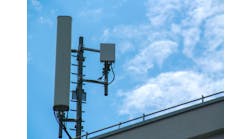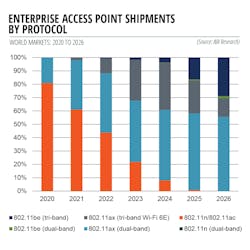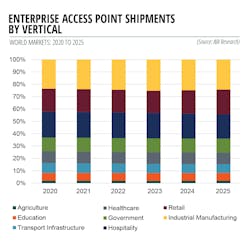Related to
Latest from 5G/Core Automation/Operations
ORAN=Oh Rats, Another Nightmare!
Is 5G Parting Ways?
The Private Partners of Wi-Fi and 5G
The enterprise Wi-Fi market is currently undergoing one of the most significant evolutions in its history. Driven by a desire to take advantage of the new 6 GHz spectrum, which offers the prospect of greatly improved throughput and latency rates as well as reduced congestion on legacy bands, enterprise will see rapid rates of Wi-Fi 6E adoption. ABI Research forecasts that shipments of Wi-Fi 6E access points will rise from 1.5 million in 2022 to 5.2 million in 2024.
Spectrum expansion is just one facet of the market revolution, as the technological underpinnings of Wi-Fi are soon to be upgraded with Wi-Fi 7. The adoption of Wi-Fi 7 access points will accelerate following the protocols standardization in 2024, and just two years later, most 6 GHz enabled access point shipments will be supporting Wi-Fi 7. (See Figure 1.) Another area to keep an eye on is IT/OT convergence. While a large chasm remains between the two domains, strategies to pursue convergence are beginning to materialize, which will stimulate further Wi-Fi innovation.
Perhaps one of the most impactful developments will be the maturing of the convergence of Wi-Fi and 5G private networks. We are now transitioning to a world in which it is not only technically possible for Wi-Fi and cellular to coexist in the same private network, but one that is becoming a vital solution in many applications. The market-leading private network solutions of the future will be those that can leverage both technologies in an interoperable manner.
Private networks that incorporate both Wi-Fi and 5G stand to benefit from the best of both technologies—from 5G’s ultra-low latency, extended range, impenetrable security, and impeccable reliability, and from Wi-Fi’s reduced deployment costs and complexity, generational backward compatibility, alongside a greater existing market familiarity with the technology.
Yet, converged private networks will not be adopted across the board. Traditional carpeted IT enterprises will continue to rely upon familiar and trustworthy Wi-Fi technology, as will verticals that operate in predominantly indoor environments with few mission-critical applications, notably education, hospitality, and retail. (See Figure 2.)
On the other side of the spectrum, industries spanning vast outdoor environments, such as agriculture, will be better suited for cellular solutions. The sweet spot for converged networks will be those industries which have a high reliance upon mission-critical applications that require long ranges and ultra-low levels of latency.
The three industry verticals which have been identified as having the greatest potential for Wi-Fi/5G converged private networks penetration are:
- industrial manufacturing
- warehousing
- healthcare
The best-suited applications for this include:
- Automated Guided Vehicles (AGVs)
- Autonomous Mobile Robots (AMRs)
- AMR visual fusion
- Augmented Reality (AR)
- Virtual Reality (VR)
“Perhaps one of the most impactful developments will be the maturing of the convergence of Wi-Fi and 5G private networks. We are now transitioning to a world in which it is not only technically possible for Wi-Fi and cellular to coexist in the same private network, but one that is becoming a vital solution in many applications.”
Wi-Fi innovation over the next half-decade will be multi-faceted, spanning both protocol and spectrum upgrades on one hand, to new applications of the technology and advancements in cellular convergence on the other. Keeping a finger on the pulse of these developments is vital for vendors at all levels of the supply chain.
REFERENCES AND NOTES
These findings are from ABI Research’s Enterprise Wi-Fi and the Path to IT/OT & 5G/Wi-Fi Private Network Convergence application analysis report. This report is part of the company’s Wi-Fi, Bluetooth & Wireless Connectivity research service, which includes research, data, and analyst insights.
ABOUT THE AUTHOR
Andrew Spivey is Industry Analyst at ABI Research. He has more than 5 years of experience in qualitative analysis and market forecasts for consumer and enterprise Wi-Fi and wireless infrastructure. For more information, please visit www.abiresearch.com. You can also follow us on Twitter @ABIresearch.

Andrew Spivey | Industry Analyst, ABI Research
Andrew Spivey is Industry Analyst at ABI Research. He has more than 5 years of experience in qualitative analysis and market forecasts for consumer and enterprise Wi-Fi and wireless infrastructure. For more information, please visit www.abiresearch.com. You can also follow us on Twitter @ABIresearch.








